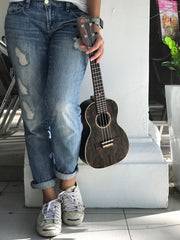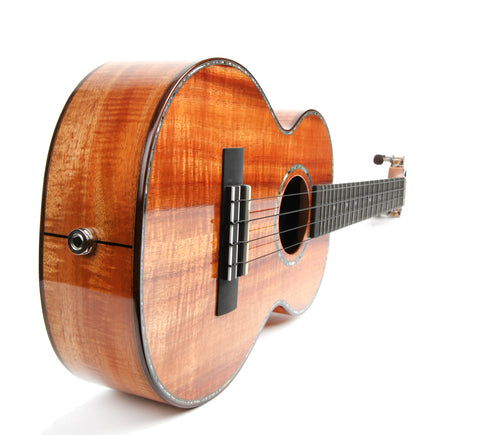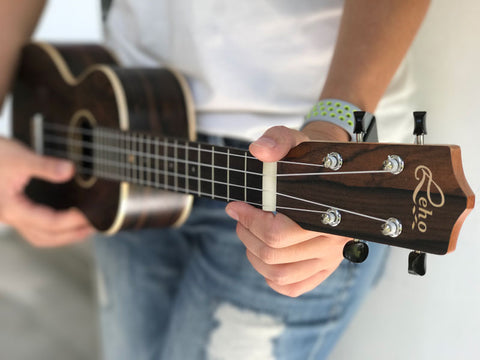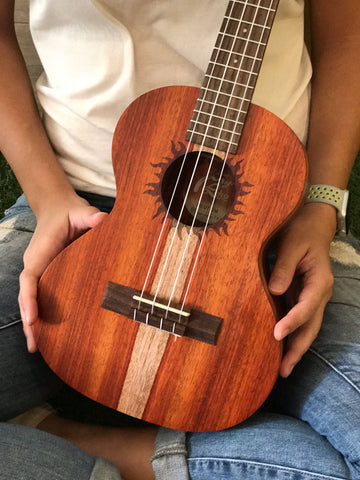Your Cart is Empty
FREE local (SG) shipping 3-5 days (min. spend $100). No discount code needed.

Daunting as it may seem–with the hundreds of different models out there offering endless combinations of wood/finishes/embellishments, the fundamentals are still the same on how to choose your first ukulele. At UKULELE MOVEMENT, we will help you determine what would be the most appropriate for you based on your physical size, budget, and taste.

The concert ukulele is a good starter ukulele for players who want a classic ukulele sound but with more space for their fingers to move (the fret distance is wider than that of the soprano ukuleles).
Many professional players choose tenor ukuleles because of its resonance, projection, and the longer fretboard which is essential for a wider range of notes. Tenor ukuleles are good for fingerstyle solos and instrumentals.
Baritone ukuleles being larger, sound more like a guitar. They are tuned like the first four strings of a guitar DGBE. This makes the transition easier for a guitarist in terms of both the size and the tuning. However, as it is not a common size, most song arrangements and tabs are written for the standard C-tuning and D-tuning.

Most beginners “outgrow” their cheap ukuleles within a few weeks and worst still, some give up because it is frustrating when the intonation is wrong even when you’re playing it correctly. So it is advisable for beginners to get a fairly decent quality ukulele that they can progress with.
A ukulele of decent quality generally costs between S$60-$150. A reputable brand ukulele with all-solid premium wood like Hawaiian koa can cost up to thousands.
 Different woods on the ukulele produce a different sound. Mahogany-top ukuleles tend to sound more mellow and warm while spruce and cedar top ukuleles sound bright and loud.
Different woods on the ukulele produce a different sound. Mahogany-top ukuleles tend to sound more mellow and warm while spruce and cedar top ukuleles sound bright and loud.
A common guitar and ukulele wood combination is to use Spruce for the top soundboard and Mahogany for the back and sides to give it more low-end bass. Rosewood was commonly used for the back and sides as well as for the fingerboard but due to recent amendments to the CITES regulations, more manufacturers are switching to more sustainable wood sources. For more information on wood & sound, read article on Tonewoods by Simon Mok.
The action of the strings plays a big part in the playability of the ukulele.  The action refers to the height between the top of the fret wire and the strings. The lower the action, the easier it is to play as not much pressure is required to press the strings. An action that is too low will set the strings buzzing when played so a fine balance needs to be achieved. Cheap or poorly made ukuleles often have very high action, resulting in poor playability.
The action refers to the height between the top of the fret wire and the strings. The lower the action, the easier it is to play as not much pressure is required to press the strings. An action that is too low will set the strings buzzing when played so a fine balance needs to be achieved. Cheap or poorly made ukuleles often have very high action, resulting in poor playability.
 There are many different types and brands of strings for ukulele in the market. Strings play an important role in the sound of the ukulele. Good strings give good tension for ease of play and provide a good tone. Aquila strings are the most popular and most recommended strings for ukuleles. Its patented strings are made of Nylgut® which is a synthetic gut material with similar acoustical qualities of gut but without the shortcomings of high cost and short string life. Nylgut® offers greater resistant to wear and has great immunity to climate changes.
There are many different types and brands of strings for ukulele in the market. Strings play an important role in the sound of the ukulele. Good strings give good tension for ease of play and provide a good tone. Aquila strings are the most popular and most recommended strings for ukuleles. Its patented strings are made of Nylgut® which is a synthetic gut material with similar acoustical qualities of gut but without the shortcomings of high cost and short string life. Nylgut® offers greater resistant to wear and has great immunity to climate changes.
In recent years, fluorocarbon strings have gained in popularity due to the tone and durability of the strings. Again, there are many brands out there and it really is a very personal choice when it comes to strings. Some like their ukuleles to sound bright, other like them mellow, and yet others want only clarity. At UKULELE MOVEMENT, we carry a range of the best you can find, as they have been extensively tested in-house.
 There are generally 2 different types of tuning machines (tuners) for the ukulele; friction pegs (left) or geared tuners (below right). Friction pegs as the name suggests, tune the instrument through friction of the pegs. The strings are tightened or loosened with a slight twist of the pegs. It takes a bit of trial and error to get the tuning right and it is not as easy to keep the instrument in tune since a slight move of the peg can affect the tuning by quite a bit. Tightening the screws at the tip of the pegs can help prevent it from turning after you have tuned your ukulele.
There are generally 2 different types of tuning machines (tuners) for the ukulele; friction pegs (left) or geared tuners (below right). Friction pegs as the name suggests, tune the instrument through friction of the pegs. The strings are tightened or loosened with a slight twist of the pegs. It takes a bit of trial and error to get the tuning right and it is not as easy to keep the instrument in tune since a slight move of the peg can affect the tuning by quite a bit. Tightening the screws at the tip of the pegs can help prevent it from turning after you have tuned your ukulele.
Geared tuners are a usually a better alternative for the novice as they allow for more precise tuning. Depending on the gear ratio, each turn of the peg moves the gear by just a fraction as compared to friction tuners. Hence, ukuleles with geared tuners tend to keep in tune and is easier to tune than those with friction pegs.
Depending on the gear ratio, each turn of the peg moves the gear by just a fraction as compared to friction tuners. Hence, ukuleles with geared tuners tend to keep in tune and is easier to tune than those with friction pegs.
It all boils down to personal preference, some like their headstock to look clean without any tuning pegs sticking out from the side, and some don't mind.
On a final note, choose a ukulele that you like so that you will keep playing it. And you don’t have to stop at one! Many people own a few ukuleles for playing different types of music, they are so small and light that you can often carry more than one to a jam or a performance.
Comments will be approved before showing up.